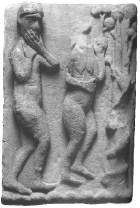Carvings in the Cathedral of Pécs
Carvings in the cathedral date from 1140-80 when the church received its final Romanesque appearance.
Of the two staircases to the crypt, it is the Northern one which is decorated with reliefs portraying the story of our first parents, below them there are statues of six apostles in niches. In the Southern staircase, the birth of Jesus, his childhood and his agony are portrayed, below them Samson's story. Series of pictures can be traced back to ancient traditions of Bible illustrations. This is what makes the pictures in the Cathedral of Pécs related to master Wiligelmo who created reliefs for the facade of the Cathedral in Modena. The Cathedral in Pécs is, however, so impressive that French influence can be assumed with good reason. It is logical to conclude that the workshop relied on traditions of long ago. This is why works of art in the cathedral of Pécs deserve special attention.
Series of pictures can be traced back to ancient traditions of Bible illustrations. This is what makes the pictures in the Cathedral of Pécs related to master Wiligelmo who created reliefs for the facade of the Cathedral in Modena. The Cathedral in Pécs is, however, so impressive that French influence can be assumed with good reason. It is logical to conclude that the workshop relied on traditions of long ago. This is why works of art in the cathedral of Pécs deserve special attention.
 The relief of the Fall shows two episodes in one composition: that of the temptation (Eve is reaching out for the snake twisting on the tree) and the gesture of Adam who is frightened (the symbolic episode of the apple stuck in the throat). Strong plasticity of figures and elaborate spatiality of reliefs indicate that masters were aware of the development of style in Burgundy.
The old man with the crown and the head with the crown were probably remains of a large scale Maiestas Domini. It is the violin-like instrument which makes it probable that the male figure is one of the 24 apocalyptic old men who used to be popular figures of portal decorations in Southern France. Outside France, it is only the Cathedral of Pécs where they represent 12th century art. Their unusually pompous clothes and embroidery-like ornaments recall costumes of the Byzantine King. The decoration hides deficiencies of modelling and spatiality.
The relief of the Fall shows two episodes in one composition: that of the temptation (Eve is reaching out for the snake twisting on the tree) and the gesture of Adam who is frightened (the symbolic episode of the apple stuck in the throat). Strong plasticity of figures and elaborate spatiality of reliefs indicate that masters were aware of the development of style in Burgundy.
The old man with the crown and the head with the crown were probably remains of a large scale Maiestas Domini. It is the violin-like instrument which makes it probable that the male figure is one of the 24 apocalyptic old men who used to be popular figures of portal decorations in Southern France. Outside France, it is only the Cathedral of Pécs where they represent 12th century art. Their unusually pompous clothes and embroidery-like ornaments recall costumes of the Byzantine King. The decoration hides deficiencies of modelling and spatiality.
Ornaments in the Cathedral of Pécs, best represented by the canopy of the St. Cross Altar, are related to churches in Pavia from the 12th century where floral ornaments covering all areas and counterbalancing architecture are major stylistic marks. Stone-cutters relied on byzantinising medieval patterns. Plastic details used to be gilded against a red background.

Previous page
 Series of pictures can be traced back to ancient traditions of Bible illustrations. This is what makes the pictures in the Cathedral of Pécs related to master Wiligelmo who created reliefs for the facade of the Cathedral in Modena. The Cathedral in Pécs is, however, so impressive that French influence can be assumed with good reason. It is logical to conclude that the workshop relied on traditions of long ago. This is why works of art in the cathedral of Pécs deserve special attention.
Series of pictures can be traced back to ancient traditions of Bible illustrations. This is what makes the pictures in the Cathedral of Pécs related to master Wiligelmo who created reliefs for the facade of the Cathedral in Modena. The Cathedral in Pécs is, however, so impressive that French influence can be assumed with good reason. It is logical to conclude that the workshop relied on traditions of long ago. This is why works of art in the cathedral of Pécs deserve special attention.

